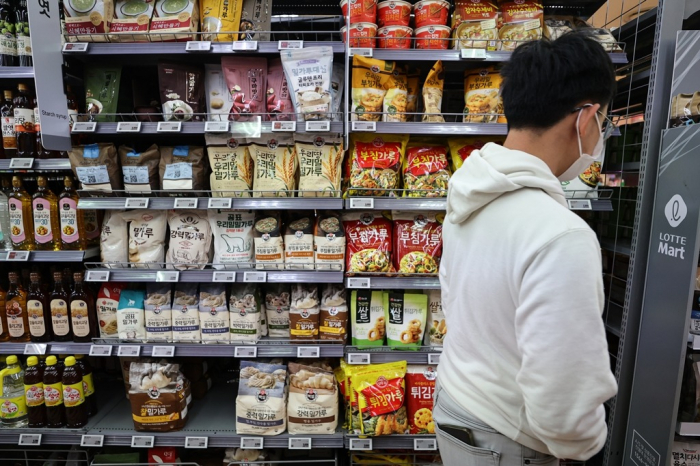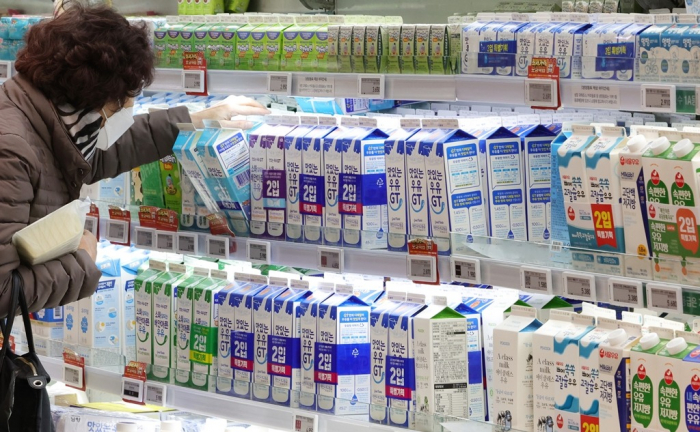Food & Beverage
South Korea’s next price cut target to ease inflation; flour prices
Share prices of flour makers underperform Kospi with Samyang and Sajodongaone down 1.5% and 1.6%; milk likely to be next
By Jun 26, 2023 (Gmt+09:00)
3
Min read
Most Read
LG Chem to sell water filter business to Glenwood PE for $692 million


Kyobo Life poised to buy Japan’s SBI Group-owned savings bank


KT&G eyes overseas M&A after rejecting activist fund's offer


StockX in merger talks with Naver’s online reseller Kream


Mirae Asset to be named Korea Post’s core real estate fund operator



South Korea urged domestic millers to cut flour prices after demanding a similar move to instant noodle makers to further ease inflationary pressure in Asia’s fourth-largest economy, adding to expectations that the government may expand such pressures to the overall food industry.
The Ministry of Agriculture, Food and Rural Affairs on Monday demanded flour makers reflect the recent decline in global wheat prices at a meeting with the Korea Flour Mills Industrial Association, a business group of major producers such as CJ CheilJedang Corp., Samyang Corp. and Sajodongaone Co.
After the government request, share prices of Samyang and Sajodongaone lost 1.5% and 1.6%, respectively, while CJ CheilJedang ended flat in Seoul’s main stock market, which gained 0.5%.
The global wheat futures prices more than halved to an average of $228 per ton in May from $475 in March last year when the war in Ukraine lifted the grain’s prices. Wheat import costs, which include expenses for shipping and other costs, tumbled by 20.6% to $394 a ton last month from a record high of $496 hit in September 2022.
The country believes the milling industry has enough room to cut flour prices as it usually takes four to six months to reflect wheat futures price moves in import costs.
That came as Bank of Korea Governor Rhee Chang-yong left the door open for another interest rate hike last month, saying consumer prices have yet to stabilize, although the economy remains sluggish.
FOOD INFLATION
Processed food prices and the cost of eating out rose 7.3% and 6.9%, respectively, in May from a year earlier, far outpacing the headline inflation of 3.3%, a 19-month low with a 1.4% fall in agricultural and livestock product prices, government data showed earlier this month.
Food price inflation also outnumbered the growth in disposable income. Processed food prices and eating-out expenses jumped 9.9% and 7.5%, respectively, in the first quarter from a year ago, while households' disposable income rose 3.4%, according to government data.
That came partially as the food industry has been raising product prices on higher raw material costs while enjoying the country’s measures to reduce import expenses such as tariff quotas, government officials said.
Some food makers reported healthy earnings. The country’s No. 1 ramen maker Nongshim Co. logged an operating profit of 63.8 billion won ($48.8 million) in the first quarter, up 85.8% from a year earlier, as sales grew 16.9%. Its smaller rival Ottogi Corp. said its operating profit rose 10.7% to 65.4 billion won with sales up 15.7%.
Earlier this month, Finance Minister Choo Kyung-ho urged instant noodle makers to cut ramen prices given falling global wheat prices.
The government is predicted to expand its price cut pressure to other food items such as milk, industry sources said.

PRICE CUTS
The food industry is poised to follow the government demand although companies in the sector said they remain under pressure from high raw material costs.
CJ CheilJedang, the country’s top miller, is in talks with Nongshim to supply flour at lower costs through incentives, which will eventually help the instant noodle maker reduce ramen prices. Other ramen producers such as Samyang Food Co. are likely to join the cut, which would be their first slash since 2010 when former President Lee Myung-bak expressed concern over their prices.
“We are considering various promotions such as incentives for large flour buyers,” said a CJ CheilJedang official. “But not an overall flour price cut given weakening earnings. We are constantly adjusting the promotion conditions.”
The company’s operating and net profits plunged 42% and 80%, respectively, in the first quarter from a year earlier.
The local food industry sources said ramen and flour makers continue to suffer from higher costs.
“They purchase wheat, a raw flour material, in six months to one year in advance in the form of futures,” said an industry source. “They are not in a position to cut prices considering logistics and labor costs.”
Nongshim reported an operating profit margin of 7% in the first quarter, up from around 3% in 2021 and 2022. That compared with Nissin Food Products Co., Japan’s top instant noodle maker, which has been enjoying an 8-10% margin each year during the period.
Write to Jung-hwan Hwang and Soo-Jung Ha at jung@hankyung.com
Jongwoo Cheon edited this article.
More to Read
-
 Food & BeverageS.Korea urges ramen makers to cut prices to ease inflation
Food & BeverageS.Korea urges ramen makers to cut prices to ease inflationJun 19, 2023 (Gmt+09:00)
3 Min read -
 Central bankBOK leaves door open for another quarter-point rate rise
Central bankBOK leaves door open for another quarter-point rate riseMay 25, 2023 (Gmt+09:00)
2 Min read -
 EconomyKorea inflation at 19-mth low; casts doubts over rate hike
EconomyKorea inflation at 19-mth low; casts doubts over rate hikeJun 02, 2023 (Gmt+09:00)
2 Min read
Comment 0
LOG IN


